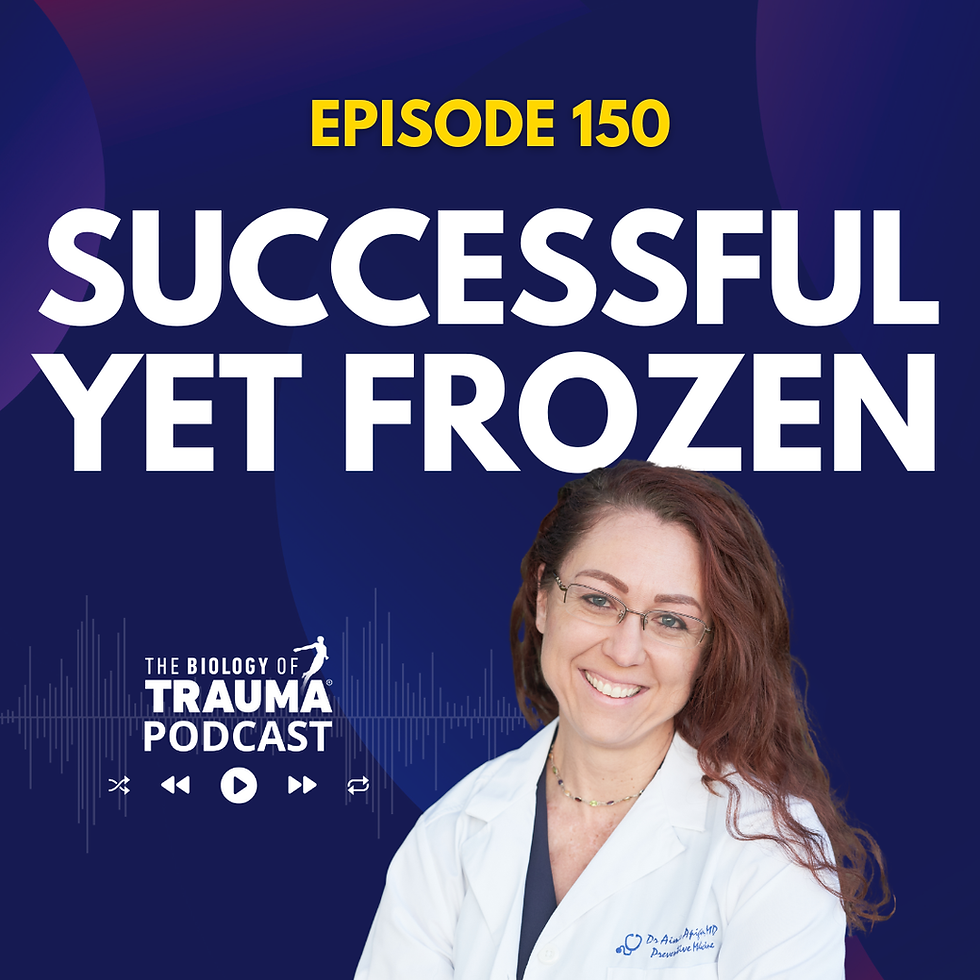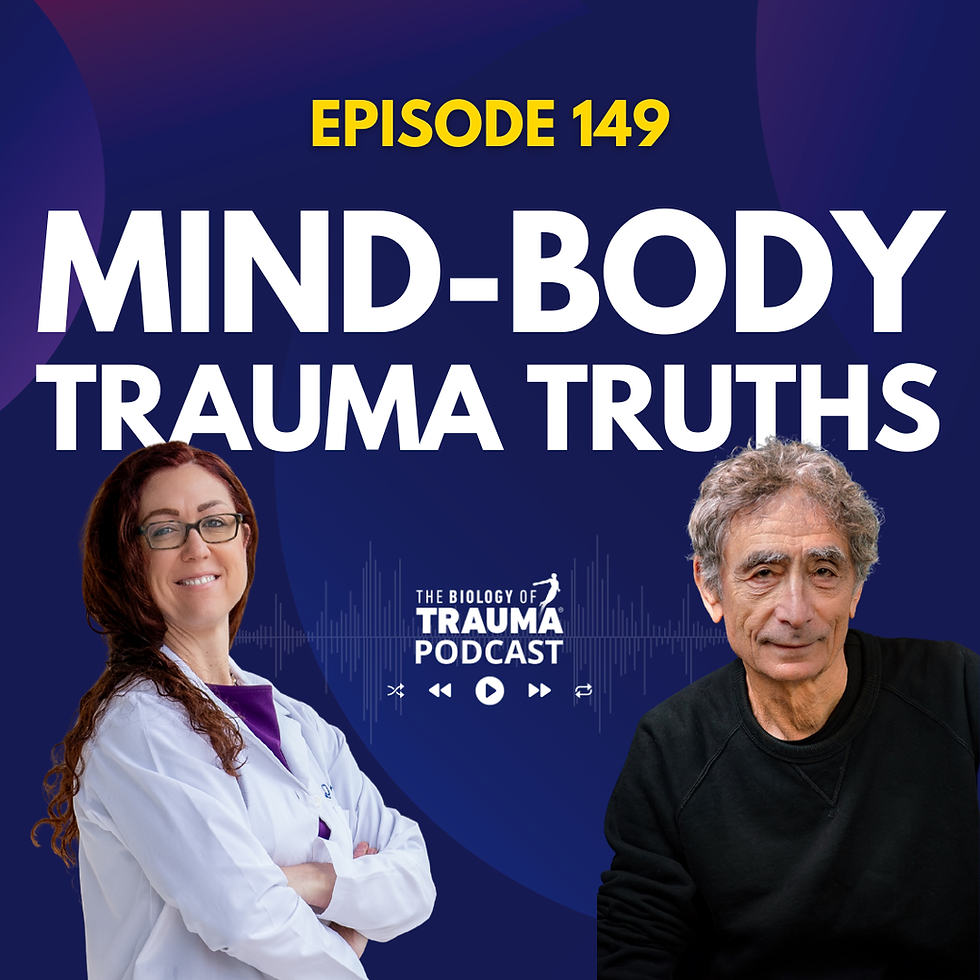Episode 74: Why Stored Traumas Become Syndromes & Somatic Solutions with Peter Levine
- THA Operations
- Nov 24
- 5 min read
Updated: 6 days ago
When Your Diagnosis Doesn't Explain Your Symptoms
You have multiple diagnoses that doctors treat separately without seeing any connection between them. Fibromyalgia and irritable bowel syndrome and chronic fatigue and POTS all coexist in your body. Medicine offers management strategies for each condition but no explanation for why they cluster together in you.
What if these aren't separate diseases but different expressions of the same underlying problem that stored trauma created?
Stored trauma becomes syndromes over time, not just isolated symptoms. Full medical syndromes that conventional medicine can't adequately explain or treat. And somatic work holds the key to addressing the root cause underneath all of them.
Dr. Peter Levine returns today as the developer of Somatic Experiencing® and founder of both the Ergos Institute of Somatic Education and Somatic Experiencing International. We discuss how stored trauma leads to syndromes through specific mechanisms and what somatic solutions actually help resolve the autonomic dysfunction driving these conditions.
Understanding the Trauma-Syndrome Connection
How is trauma work different when there's a syndrome involved versus working with trauma that manifests as psychological symptoms? Syndromes require understanding what's driving them at the deepest biological level rather than just addressing surface symptoms or even trauma memories alone.
Dr. Levine identifies the one foundational element in your body that drives syndromes across different diagnoses. This isn't multiple separate causes creating different conditions. It's one underlying issue expressing itself through various syndromes depending on your particular vulnerabilities and circumstances. That foundational issue is autonomic nervous system dysregulation from stored trauma.
Why somatic work represents one of three essential pillars for healing syndromes becomes clear when you understand that stored trauma requires three integrated approaches. Somatic work addresses the body where trauma is held. Without this somatic pillar, the other approaches can't support full healing because the biological foundation remains unstable and dysregulated.
What every physician should know but most doctors don't learn in medical training involves the direct connection between trauma and syndrome development. Dr. Levine explains what medical education systematically misses about how stored trauma creates the autonomic dysregulation that manifests as chronic syndromes. What physicians need to recognize is that many syndromes they treat symptomatically have trauma as their root cause.
The Role of Autonomic Dysfunction
Chronic syndromes often trace their origins back to childhood trauma even when symptoms don't emerge until adulthood. The patterns of nervous system dysregulation get set early in development. Your biology adapts to survive overwhelming circumstances. Decades later, those adaptive changes manifest as full syndromes that seem to appear randomly but actually follow predictable pathways from early trauma.
Understanding the Biology of Trauma® alongside Dr. Levine's Somatic Experiencing® framework reveals how developmental trauma creates vulnerability to syndromes later in life. Your autonomic nervous system learns dysregulated patterns early that affect every body system throughout your lifespan. These patterns remain dormant or compensated until additional stressors push you across the threshold into manifest illness.
What dysautonomia actually means is autonomic nervous system dysfunction where your automatic body functions stop working properly. Your heart rate, blood pressure, digestion, temperature regulation, and immune response all depend on autonomic function. When trauma dysregulates this system, multiple body functions fail simultaneously or in sequence creating complex syndrome presentations.
Dysautonomia's role in syndrome development explains why so many chronic conditions cluster together in the same individuals. When your autonomic nervous system is dysregulated from stored trauma, syndromes develop across multiple body systems because one dysregulated nervous system affects everything it controls. This is why people with fibromyalgia often have IBS, POTS, chronic fatigue, and other conditions simultaneously.
Somatic Solutions for Syndromes
The key element that makes somatic work effective with any and all syndromes involves working directly with the autonomic nervous system through the body. Dr. Levine shares what makes Somatic Experiencing® and similar approaches uniquely suited to addressing syndromes that other treatments can't resolve. This somatic principle applies universally across different syndrome presentations because it addresses the common root cause.
Why syndromes cluster together in individuals isn't coincidence or bad luck. It's the same autonomic dysregulation from stored trauma expressing itself through different body systems and creating multiple diagnostic labels. When you address the underlying autonomic dysfunction through somatic work, multiple syndromes often improve simultaneously because you're working with the shared root cause.
Specific somatic approaches that address autonomic dysfunction underneath syndromes create changes that medication and conventional treatments cannot achieve. Working with the body directly through titrated activation, pendulation between activation and settling, tracking sensations, and completing defensive responses allows your nervous system to reorganize and regulate properly. This changes the entire syndrome picture rather than just suppressing individual symptoms.
Dr. Levine emphasizes that somatic work for syndromes requires understanding trauma's role even when the person doesn't identify as having significant trauma history. Developmental trauma, medical trauma, and chronic stress all create the autonomic dysregulation that manifests as syndromes. Working somatically addresses this dysregulation regardless of whether the person remembers or acknowledges specific traumatic events.
Integration and Application
The integration of somatic work with medical treatment and psychological support creates the three pillars that syndromes require for healing. Medical support manages acute symptoms and prevents deterioration. Psychological work processes emotions and meanings around illness. Somatic work addresses the autonomic dysregulation driving the syndromes at their biological root.
Understanding why stored trauma becomes syndromes empowers you to seek appropriate treatment rather than accepting progressive decline as inevitable. Your syndromes likely reflect your nervous system's inability to regulate properly after overwhelming experiences. This is addressable through somatic approaches that work with your body's innate capacity to complete trauma responses and restore regulation.
Dr. Levine's decades of clinical experience demonstrate that even severe syndromes can improve when you address the stored trauma and autonomic dysfunction underneath them. People who've been ill for years with multiple syndromes experience significant improvement when they finally work somatically with the trauma their body has been holding and expressing through syndrome presentations.
The practical application means seeking practitioners trained in Somatic Experiencing® or similar body-based trauma approaches when you have chronic syndromes. It means understanding that your multiple diagnoses likely share one root cause in autonomic dysregulation. It means approaching healing by addressing your nervous system directly rather than only managing symptoms through medication or surgery.
Recognizing that syndromes reflect stored trauma changes your entire relationship with your illness. You're not randomly broken or genetically doomed but carrying unresolved trauma in your biology that's expressing itself through syndromes. This understanding opens pathways to healing that medical models focused only on symptom management cannot access. Your body wants to heal when you provide it with the somatic support it needs to reorganize and regulate.
This Episode Is For:
✓ People with chronic syndromes that medicine can't adequately explain
✓ Anyone with multiple diagnoses that cluster together
✓ Practitioners working with complex chronic patients who need the somatic piece
✓ Those with dysautonomia or autonomic dysfunction
✓ Anyone whose syndromes haven't responded to conventional treatment
✓ People ready to address the trauma underneath their diagnoses
What You'll Learn
Listen to hear Dr. Peter Levine explain why stored trauma becomes syndromes through autonomic dysregulation and what somatic solutions address the root dysfunction driving multiple conditions. Discover the one foundational element underneath all syndromes. Learn why syndromes cluster together and how working somatically changes the entire picture.
Your multiple syndromes might all stem from one autonomic dysfunction that stored trauma created.
Disclaimer
This podcast is for educational purposes only and is not a substitute for professional medical or mental health advice, diagnosis, or treatment. The information shared reflects my clinical expertise and research, but every person's biology and healing journey is unique. Always consult with qualified healthcare providers before making changes to your treatment plan or starting new interventions. If you're experiencing a mental health crisis, please contact emergency services or a crisis helpline immediately.
Join the Conversation
I'd love to hear your thoughts on this episode. What resonated with you? What questions came up?
Please keep comments respectful and supportive. This is a community of people committed to healing. We welcome diverse perspectives and honest questions, but we don't tolerate personal attacks, spam, or content that could harm others on their healing journey.




Comments